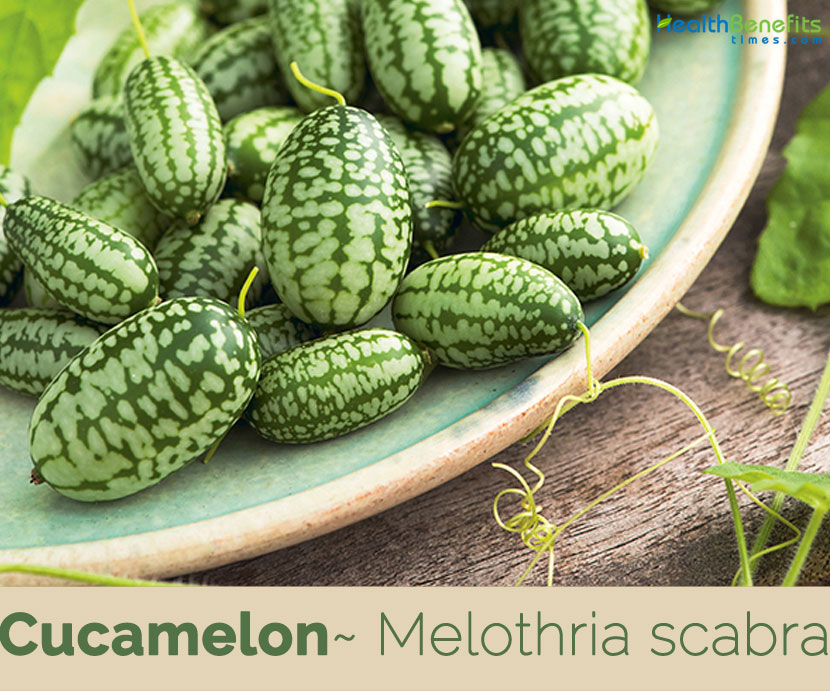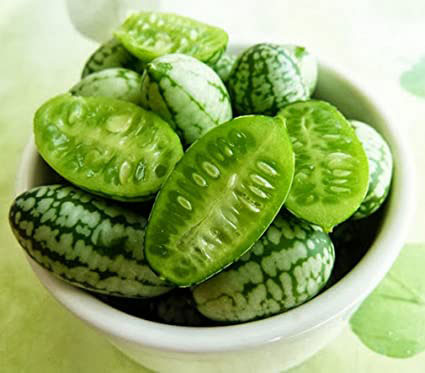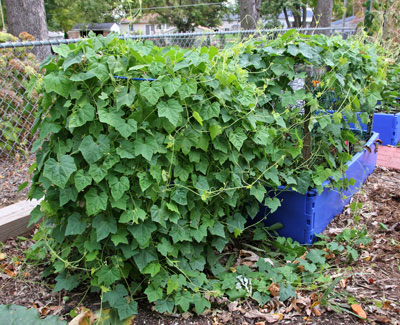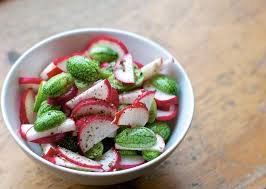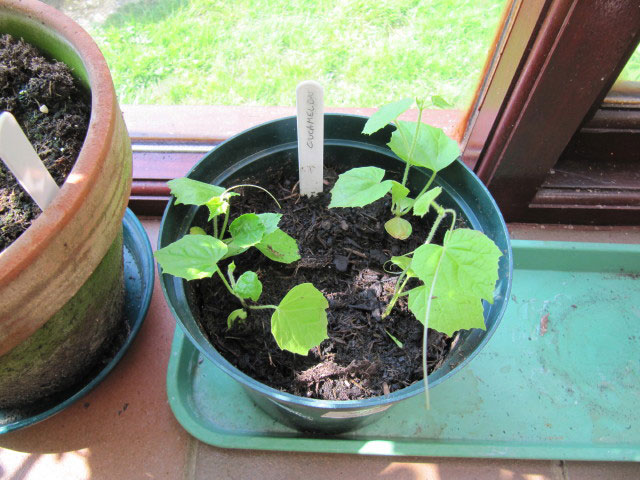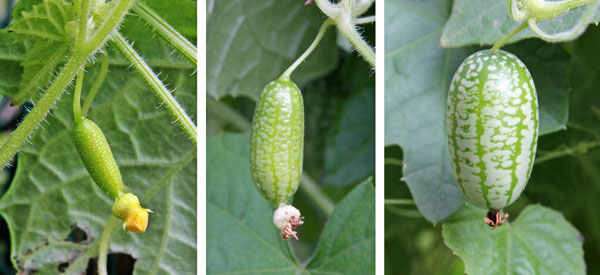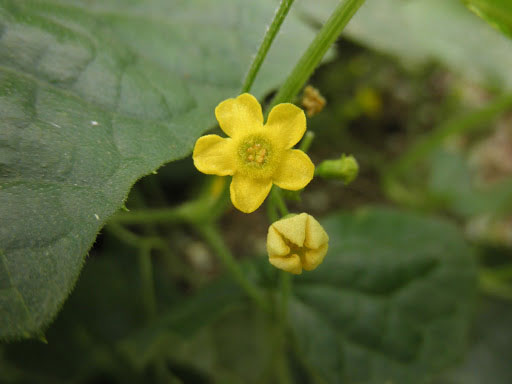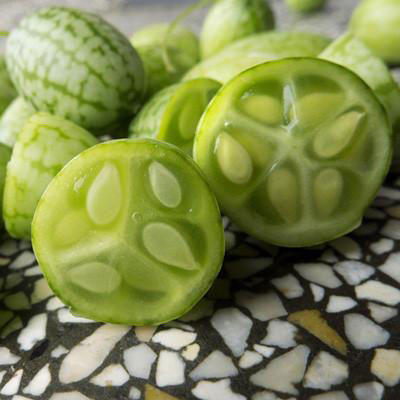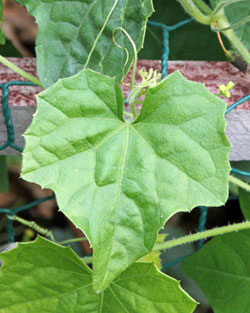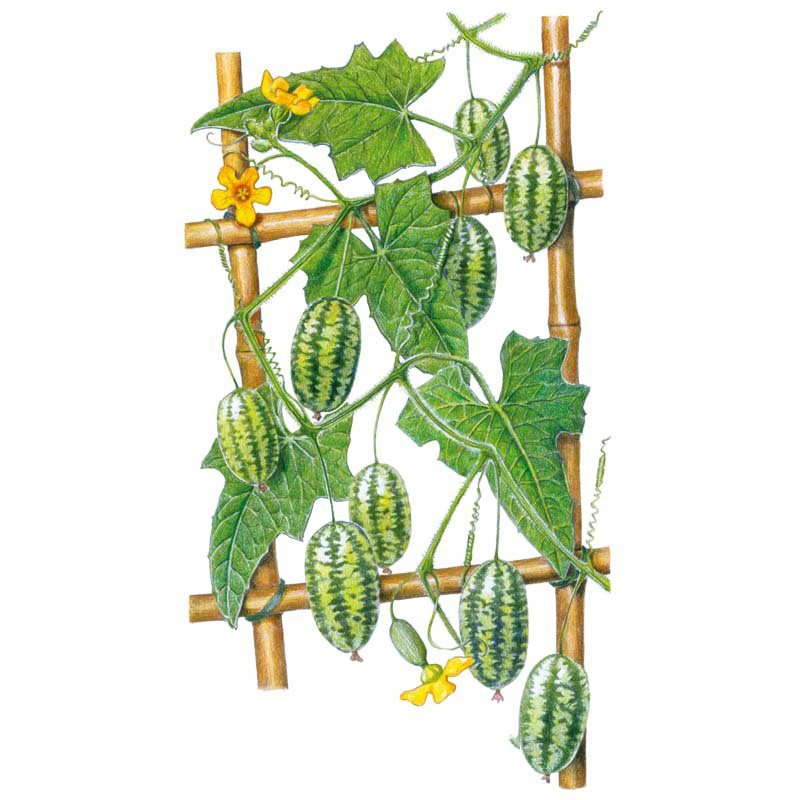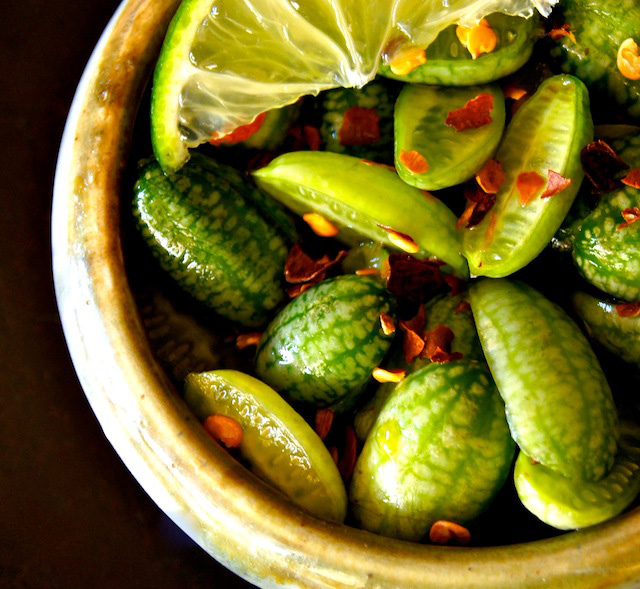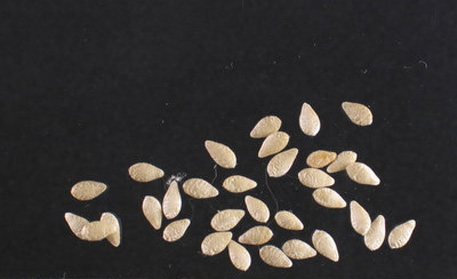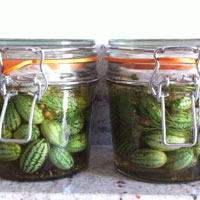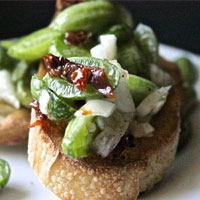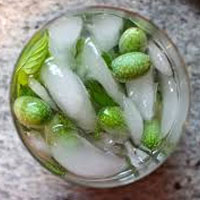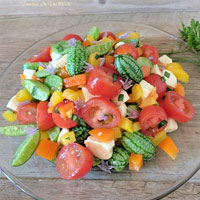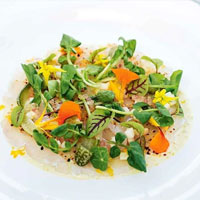Cucamelon Facts
| Cucamelon Quick Facts | |
|---|---|
| Name: | Cucamelon |
| Scientific Name: | Melothria scabra |
| Origin | Mexico and Central America |
| Colors | Green |
| Shapes | Grape sized mini melons, approximately 3 cm long and 2 cm wide |
| Flesh colors | White |
| Taste | Taste like a sour cucumber with a dash of lime |
| Health benefits | Beneficial for heart health, aging, stroke, cancer, lower cholesterol level, constipation, blood pressure, eyes and every internal organ of the body |
| Name | Cucamelon |
|---|---|
| Scientific Name | Melothria scabra |
| Native | Mexico and Central America |
| Common Names | Creeping cucumber, Cucamelon, Guadeloupe cucumber, Mexican miniature watermelon, Mexican sour cucumber, Mexican sour gherkin, Mouse melon, Pepquinos |
| Name in Other Languages | Chinese: Lǎo shǔ dōng guā (老鼠冬瓜), Lǎo shǔ guā (老 鼠瓜) English: Creeping cucumber, Cucamelon, Guadeloupe cucumber, Mexican miniature watermelon, Mexican sour cucumber, Mexican sour gherkin, Mouse melon, Pepquinos French: Concombre à confire, Concombre à confire du Mexique, Concombre du Mexique, Cornichon amer du Mexique, Mélothrie à confire, Pastèque miniature German: Cocktailgurke, Haarweibchen, Mexikanische Minigurke, Mexikanische Ziergurke Japanese: Kyūri meron (きゅうりメロン) Persian: هندوانه مینیاتوری مکزیکی Russian: Melotriia shershavaia (Мелотрия шершавая) Spanish: Melón ratón, Pepinillo agrio mexicano, Pepino amargo mexicano, Sandía miniatura Mexicana, cucamelon Swedish: Djungelgurka Vietnamese: Dưa chuột chua, Dưa hấu chuột, Dưa hấu nhỏ Mexico |
| Plant Growth Habit | Fast-growing, tender tropical herbaceous, perennial climbing vine |
| Soil | Sandy, loamy and clay soils and prefers rich, well-drained soil |
| Plant Size | About 2.5-3 m high |
| Flowering season | May to June |
| Flower | Small, solitary yellow flowers are about four millimeters in diameter with five petals are produced in the leaf axils. This plant is unusual among cucurbits in that female flowers appear before male flowers, not the reverse like regular cucumbers |
| Fruit Shape & Size | Grape sized mini melons, approximately 3 cm long by 2 cm wide (1.25 inch long by 0.8 inches wide) |
| Fruit Color | Green colored |
| Fruit Skin | Thin, yet firm |
| Flesh | White, crisp interior flesh has a crunchy texture |
| Propagation | By seed |
| Plant Parts Used | Fruits |
| Seed | Small about 1/8 inch long |
| Taste | Taste like a sour cucumber with a dash of lime |
| Season | July to September |
| Other Facts |
|
Plant Description
Cucamelon is a fast-growing, tender tropical herbaceous, perennial climbing vine that can grows up to 2.5-3 m high under proper conditions. The plant prefers plenty of direct sunlight in order to grow well. The plant is found growing in sandy, loamy, clay soils and prefers rich, well-drained soil. They are drought resistant and pest-resistant relative to other cucumbers. Just like other cucumber, these plants are monoecious, producing both male and female flowers on the same plant. These plants can pollinate themselves, but the individual flowers are not self-fertile. Flowers are small, solitary yellow about four millimeters in diameter with five petals. This plant is unusual among cucurbits in that female flowers appear before male flowers, not the reverse like regular cucumbers. Flowering normally takes place between May to June. Fruits develop at the base of the female flower.
Fertile flowers are followed by grape sized small, oblong melons that have green, glabrous surface with white stripes. Fruits are approximately 3 cm long and 2 cm wide (1.25 inch long and 0.8 inches wide) and have numerous seeds. The fruits are edible and can be eaten either raw or cooked. The skin and the seeds are also edible. The fruits are an ideal choice for pickling and making salsas.
Traditional uses and benefits of Cucamelon
- Some people claim that this super fruit is good for your heart, protects against aging, lowers your risk of stroke and has anticancer properties.
- Cucamelon helps to revitalize the cells, tissues as well as the different organs, thereby inhibiting the aging process.
- This fruit helps to promote the cardiac functions and also prevent development of cancer.
- The fruit has a useful antioxidant that helps to promote the functioning of the heart.
- Cucamelons are also high in potassium and Vitamin C which can lower high levels of cholesterol in our body and boost the work of the body organs.
- Cucamelon peel is a good source of dietary fiber that helps reduce constipation.
- It offers some protection against colon cancers by eliminating toxic compounds from the gut.
- It is a very good source of potassium; it helps reduce blood pressure and heart rates by countering effects of sodium.
- Antioxidants present in the fruit helps the body prevent or at least prolong the natural changes of aging by protecting and rejuvenating cells, tissues and organs.
- Cucamelons have the power to lower down bad cholesterol levels.
- Cucamelons are also proven to be good for the eyes and every internal organ of the body.
Culinary uses
- Cucamelons can be eaten alone, pickled, used in salsa, or even placed into a drink for an added flavor.
- Cucamelons can also be used as a substitute for pickling cukes.
- Young, tender fruits are best for eating raw, while the older fruits with more developed seeds are better for pickling.
- These fruits are also a great way to garnish a variety of fancy drinks and beverages at a party if you are looking for a little extra “pizzazz” to be added to your cups.
- Adding several Cucamelons to a glass of water can offer flavored water like one with added cucumber and/or lime juice.
- It’s a great, healthy alternative to sugary teas, juices, or sodas to add to water and enjoy sipping a refreshing drink any time of the year.
- They can also be eaten just like grapes right out of the bag or out of a bowl.
- Mix whole cucamelons (fresh, blanched or pickled) into a bowl of olives and serve with drinks.
- Spear them with toothpicks and pop them into a martini.
- They can be served with pretzels and chips.
- It tastes good in a simple ham sandwich or with a fancy cheese-board.
- They are excellent in stir-fries and can be chopped and added to salsas for extra texture and flavor.
- Fruits can be fried in garlic and olive oil and served as a side dish.
Steps needed to grow Cucamelons
1. Finding the seeds
The cucamelon seeds are really rare to find because it is a hybrid fruit. However, you can purchase them online. If you do decide to buy the seeds, make sure that they are organic and are free of pesticides.
If you do have the fruit at home, you can extract the seeds from it when it’s ripe and place them in a jar full of water for one week. After, rinse the seeds and use a towel to dry them off. Then store them in an envelope somewhere that is cool.
2. Climate
To fully grow, Cucamelons need 65-75 days. They also need warm weather and 75F to 85F temperature soil. If you live in an area that is colder, grow the Cucamelons in a pot inside of the house in a bright and warm place.
3. Growing them at home
In order to grow cucamelons, you will need to root them at home first between the months of April and May. Plant the seeds in a pot and keep them in the house to protect them from colder temperatures.
If you do have a greenhouse, you can plant them in a pot and half an inch into the soil, and make sure that the greenhouse’s temperature is around 72F.
4. Location
Cucamelons will need 12 square inches of space between each pot that will be planted. It is important to choose the right sunny location for this fruit because it needs up to 6 hours of direct sunlight during a day.
5. Wire Cage
Since the Cucamelon is a vining plant, it can grow up to 10 feet, which is the reason why you should use a wire cage or a small trellis in order to keep the stem and roots of the fruit steady.
6. Soil
The perfect soil to use for the cucamelons will be one that is made of compost or manure since the fruit depends on nutrition-rich soil. It also drains nutrition pretty easily.
Additionally, you can add a tablespoon of 6-10-10 analysis fertilizer inside of the planted fruit individually. Furthermore, you can add tiny lava rocks to encourage improved soil drainage.
This plant will also require a 3-inch side compost dressing each month, something that you will need to start two months after first planting your cucamelon.
7. Water
This fruit needs a steady and ongoing moisture supply. They require an inch of water for every 5-7 days, particularly during summer. This will guarantee the growth and development of the fruit.
For that reason, you will need to water the first 6-15 inches of the soil frequently. For the people that live in the colder areas, you can use a 3-4 inch layer of lightweight mulch to border the fruit.
8. Pests and re-seeding
The cucamelons are very durable fruits and can undergo unexpected conditions. This makes them resistant to pests and diseases as well. Also, this fruit re-seeds itself so you will enrich your garden with these amazing plants.
9. Vines
You can wrap the vines together as they remain to grow to avoid twisting and harm of the tendrils. The vines will pick up the pace and shape the way you will arrange them since they are very flexible to change.
10. Harvesting
After their blossoming, the cucamelon will start showing their fruits soon. As soon as the fruit is grown to the size of a grape, it is ready to be harvested.
Since the fruits grow differently, you do not have to harvest them all at the same time. When picking the fruit, be careful not to tear the plant. The season for harvesting cucamelon starts in July and ends in mid-November.
11. Pruning
Cucamelons don’t require trimming, but once the season comes to an end you can do it either way, especially if you see dying leaves.
Popular recipes with Cucamelon
Cucamelon pickles
Ingredients
- A large sterilized jar that you plan to use for storing your pickles.
- 2 cups of cucamelons
- 1 tablespoon of yellow mustard seeds
- 1 tablespoon of chopped fresh dill
- 1 tablespoon of coriander seeds
- 1 tablespoon of coarse salt
- ½ to ¾ cup of apple cider vinegar
- ¾ cup of water
Directions
- In a pan, bring the apple cider vinegar and water to the boil and add the salt. Allow to cool.
- Put the prepared cucamelons and other ingredients in your sterilized pickling jar and pour over the cooled vinegar mixture.
- There should be enough liquid to completely cover the cucamelons. If you need more liquid, repeat step 1 with the quantity of vinegar and water you require.
- Close the jar lid tightly and let stand for 4 or 5 days.
- Your delicious cucamelon pickles are now ready for consuming.
Cucamelon Bruschetta
Ingredients
- 1 Pint Cucamelons, cut in half
- 2 Cipollini Onions, peeled & finely diced
- 1 Bird’s Eye Chili finely sliced. (add another if you like it really spicy)
- Small Handful of Basil or Mint, chiffonade
- 1/4 C Good Quality Olive Oil
- 2 Tbsp. Apple Cider Vinegar
- 1 Tbsp. Local Organic Honey
- Juice of Half a Lime
- Coarse Sea Salt & Fresh Cracked Black Pepper
- Toasted Bread to Serve
Directions
- Toss the first 4 ingredients in a bowl. Set aside.
- Put the rest of the ingredients in a mason jar and season to taste. Cover with a lid and shake baby shake until emulsified.
- Pour over prepared vegetables. Stir well, season if need be. Spoon over toasted bread.
Cucamelon Mojito
Ingredients
- ½ oz. Lime Juice
- 1 Teaspoon Superfine Sugar
- A bunch of fresh mint leaves
- 2 oz. Diplomático Rum
- Club Soda
- 4 or 5 cucuamelon, optional, duh
Directions
- Place ice, rum, mint leaves, lime juice and sugar in glass and muddle.
- Top off each glass with splash of club soda.
- Garnish with lime wedge and mint leaves.
- Top with fresh cucamelons.
Cucamelon salad
Ingredients
- 1 1/2 cup cucamelons
- 1 8 oz container cherry tomatoes (if homegrown, 1 1/2 cups)
- 1 medium sized orange sweet pepper
- 1 medium sized yellow sweet pepper
- 8 oz Fresh mozzarella cheese
- 1/3 cup seasoned rice vinegar
- 1 Tbs. basil, parsley or other fresh herbs, chopped
- 2 Tbs. Olive oil
- Salt and pepper to taste
Directions
- Cut cucamelons lengthwise to allow the most surface exposure. This gives the best flavor since the dressing and spices can really penetrate the surface area of the fruit.
- Cut cherry tomatoes in half and dice peppers.
- Toss cucamelons, tomatoes, peppers and herbs with rice vinegar. Cover and refrigerate 1 hour.
- Cut Fresh mozzarella cheese into small pieces about the same size as the tomato halves.
- Once chilled, drizzle the olive oil over the salad and toss to coat.
- Add mozzarella and toss gently.
- Sprinkle with salt and pepper. Serve while still cold.
Snapper sashimi, cucamelon and jalapeno
Ingredients
- 2 x 120 g sashimi-grade skinless pink snapper fillets, pinboned, very thinly sliced (substitute sashimi-grade king fish)
- 1 Pink Lady apple, peeled, core removed, cut into 5 mm dice
- Picked watercress, baby red vein sorrel leaves (optional), finger lime pearls (optional) and extra virgin olive oil, to serve
Jalapeno Mayonnaise
- 1/2 cup (150 g) whole-egg mayonnaise
- 1 tbs. pickled jalapeño, finely chopped
- Finely grated zest and juice of 1/4 lemon
Pickled Cucamelon
- 50 ml chardonnay vinegar (substitute white wine vinegar)
- 25 g caster sugar
- 1 star anise
- 2 black peppercorns
- 1/2 long red chili, finely chopped
- 12 cucamelons (substitute chopped Lebanese cucumber), quartered
Directions
- For the pickled cucamelon, place vinegar, sugar, star anise, peppercorns and chili in a small saucepan and bring to a boil over a high heat for 1 minute.
- Remove from heat, pour into a small heatproof container with a lid and allow cooling completely.
- Add cucamelons and stir to coat. Set aside, covered, for 1 hour, or longer if time allows, then drain.
- For the jalapeño mayonnaise, whisk all ingredients together in a small bowl.
- When ready to serve, spoon jalapeño mayonnaise among serving plates, using the back of the spoon to spread mayonnaise into a thin layer.
- Top with snapper and scatter with cucamelon, apple, watercress, baby red vein sorrel, if using, and finger lime pearls, if using, then drizzle with oil.
References:
https://en.wikipedia.org/wiki/Melothria_scabra
https://npgsweb.ars-grin.gov/gringlobal/taxonomydetail.aspx?id=24053
http://www.theplantlist.org/tpl1.1/record/kew-2373236
https://gd.eppo.int/taxon/MEESC


